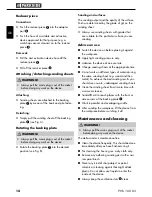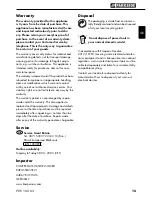
10
PHS 160 B3
GB
DETAIL SANDER
PHS 160 B3
Introduction
We congratulate you on the purchase of
your new device. You have chosen a high
quality product. The instructions for use
are part of the product. They contain important
information concerning safety, use and disposal.
Before using the product, please familiarise
yourself with all of the safety information and
instructions for use. Only use the unit as described
and for the specifi ed applications. If you pass the
product on to anyone else, please ensure that you
also pass on all the documentation with it.
Proper use
This device – when combined with the appropri-
ate sandpaper – is suitable for dry-sanding wood,
plastic, metal, fi ller and painted surfaces. The
device is particularly suitable for corners, profi les
or diffi cult to access places. Any other use or
modifi cation to the device shall be considered as
improper use and could give rise to considerable
dangers. We will not accept liability for loss or
damage arising from improper use. Not suitable
for commercial use.
Features
Mains lead
Adapter port
Reducer piece for external vacuum extraction
a
Tab (dust box)
b
Dust box for self-generated dust extraction
Release button - dust collection box
Ventilation slots
Patented backing plate (360° rotatable)
ON / OFF switch
Included items
1 Detail sander PHS 160 B3
1 Sanding sheet (Grit 120)
1 Reducer piece for external vacuum extraction
1 Operating instructions
Technical details
Nom. power input:
160 W
Nominal voltage:
230 V∼ 50 Hz
Non-load speed:
n
0
= 13000 min
-1
Non-load
oscillation speed:
n
0
= 26000 min
-1
Backing plate:
360° rotatable
Protection class:
II /
Noise and vibration data:
Measured values for noise are determined in ac-
cordance with EN 60745. The A-weighted noise
level of the electrical power tool are typically:
Sound pressure level: 80 dB(A)
Sound power level:
91 dB(A)
Uncertainty K:
3 dB
Wear ear protection!
Evaluated acceleration, typical:
Hand / arm vibration ah = 4.7 m/s
2
Uncertainty K = 1.5 m/s
2
The vibration level specifi ed in these instructions
was measured in accordance with an EN 60745
standardised measurement process and can be used
to compare equipment. The vibration emission value
specifi ed can also serve as a preliminary assess-
ment of the exposure. The vibration level will change
according to the application of the electrical tool
an in some cases may exceed the value specifi ed in
these instructions. Regularly using the electric tool in
such a way may make it easy to underestimate the
vibration.
If you wish to make an accurate assessment of the
vibration loads experienced during a particular pe-
riod of working, you should also take into account
the intervening periods of time when the device is
switched off or is running but is not actually in use.
This can result in a much lower vibration load over
the whole of the period of working.
IB_100087_PHS160B3_LB1.indb 10
28.05.14 13:41
Summary of Contents for PHS 160 B3
Page 3: ...A B a b...






































